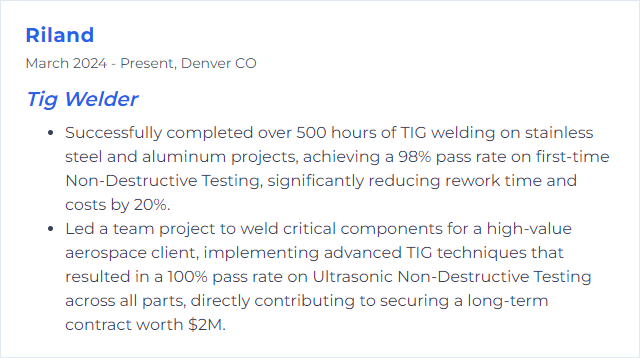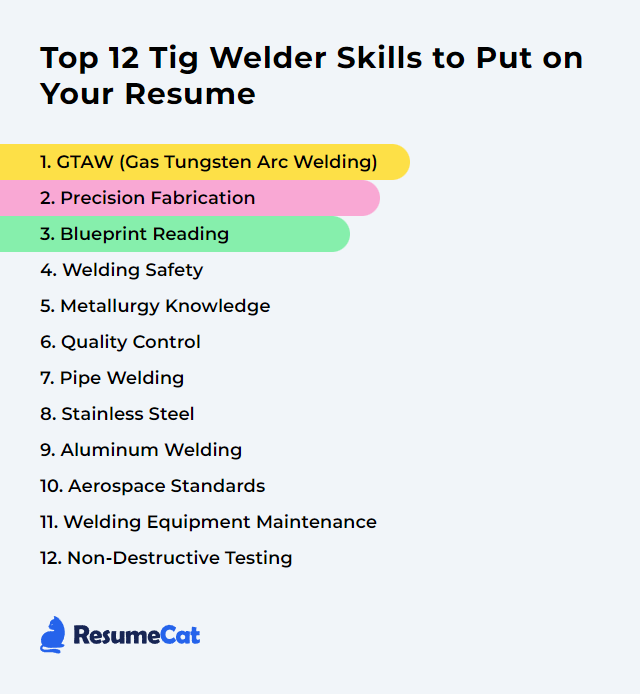Top 12 Tig Welder Skills to Put on Your Resume
Mastering TIG welding blends precision with feel. The hand knows when the puddle breathes right, and the parameters sing together. If you want to turn that into job offers, show the skills that prove you can hit tight tolerances, read complex drawings, and keep defects out of sight.
TIG Welder Skills
- GTAW (Gas Tungsten Arc Welding)
- Precision Fabrication
- Blueprint Reading
- Welding Safety
- Metallurgy Knowledge
- Quality Control
- Pipe Welding
- Stainless Steel
- Aluminum Welding
- Aerospace Standards
- Welding Equipment Maintenance
- Non-Destructive Testing
1. GTAW (Gas Tungsten Arc Welding)
GTAW, also called TIG, uses a non-consumable tungsten electrode with inert shielding gas (argon or an argon/helium blend) to create clean, precise welds. Filler metal is added only when the joint calls for it. Control is the whole game—arc length, amperage, and travel speed weaving together for immaculate beads.
Why It's Important
It delivers crisp, low-spatter welds on thin and critical parts, across many alloys, where cosmetics and integrity both matter.
How to Improve GTAW (Gas Tungsten Arc Welding) Skills
Pick the right tungsten: 2% lanthanated works brilliantly on modern inverters for both DC and AC. Zirconiated can help on AC aluminum. Grind lengthwise; keep tips consistent.
Prep like a pro: Degrease, remove oxides, and use dedicated brushes for stainless and aluminum. Back-purge stainless, titanium, and nickel alloys when the root must stay bright.
Shielding gas: Pure argon covers most jobs. Add helium for thicker sections or higher heat input. Use a gas lens for smoother laminar flow.
Dial in flow: Typically 15–20 CFH. Larger cups or drafts may need more; a gas lens often lets you use less.
Heat control: Foot pedal or fingertip control keeps distortion and burn-through in check. Pulse can tighten profiles and reduce heat tint.
Torch angles: About 10–20 degrees from vertical, short arc length, and steady travel. Keep the tungsten out of the puddle. No dipping.
Filler choice: Match base metal chemistry and service needs. Keep filler rods clean and dry.
Consistency: Practice feeding techniques (dab, lay-wire, walking the cup). Repetition builds muscle memory.
PPE: Proper shade, FR clothing, gloves, and eye/respiratory protection, especially in tight spots or on exotic alloys.
How to Display GTAW (Gas Tungsten Arc Welding) Skills on Your Resume

2. Precision Fabrication
Precision fabrication means parts fit without a fight. Joints are prepped right, fixtures hold steady, and the bead lands exactly where the print says it should.
Why It's Important
You hit tight tolerances and clean aesthetics, which keeps rework off the clock and customers happy.
How to Improve Precision Fabrication Skills
Control arc length: Short, steady arcs improve penetration and bead shape.
Fixturing and setup: Use clamps, jigs, and strongbacks. Sequence tacks to minimize pull and distortion.
Measure twice: Squares, calipers, and gauges are your daily toolkit. Verify datums before you spark up.
Joint prep: Consistent bevels, land, and root openings. Deburr and fit-up tight where spec allows.
Heat discipline: Control interpass temperatures; let parts cool as needed to avoid creeping distortion.
Document parameters: Record amperage, travel speed, filler, gas, and cup to repeat success.
How to Display Precision Fabrication Skills on Your Resume

3. Blueprint Reading
Reading prints means translating lines, views, and symbols into exact cuts and welds. Dimensions, tolerances, and weld symbols guide the whole build.
Why It's Important
It prevents guesswork. You meet design intent, avoid clashes, and deliver parts that assemble the first time.
How to Improve Blueprint Reading Skills
Learn weld symbols: Groove types, fillet sizes, contour, finish, and tail notes. Know the standards you work under.
Views and sections: Get fluent with section views, detail callouts, and scaling.
GD&T basics: Flatness, perpendicularity, true position—understand what actually matters at assembly.
Practice with real prints: Build from simple brackets to multi-part assemblies. Increase complexity as confidence grows.
Clarify early: Confirm ambiguities with engineering before cutting metal.
How to Display Blueprint Reading Skills on Your Resume
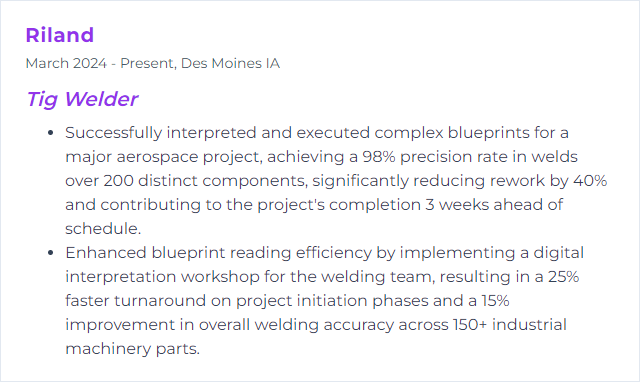
4. Welding Safety
Safety in TIG work means shielding from UV, heat, and fumes, managing electricity smartly, and keeping the work area clean and ready for the unexpected.
Why It's Important
Because one slip—UV flash, shock, fumes—can end a shift quick. Good habits keep you welding tomorrow.
How to Improve Welding Safety Skills
PPE always: Proper shade helmet, FR jacket, gloves, boots. Safety glasses under the hood. Hearing protection when grinding.
Ventilation and fume extraction: Local extraction near the arc. Extra care on stainless, nickel, and exotic alloys.
Electrical discipline: Dry gloves, intact leads, correct grounding. Inspect connectors and insulation.
Gas and fire control: Secure cylinders, check leaks, clear combustibles. Keep extinguishers visible and charged. Use a fire watch when needed.
Housekeeping: Organized cables, dry floors, tidy benches. Sparks love clutter.
Training and refreshers: Stay current on company procedures and relevant safety standards.
How to Display Welding Safety Skills on Your Resume

5. Metallurgy Knowledge
Metallurgy for TIG means knowing how metals behave under heat: conductivity, expansion, phase changes, and what happens as they cool.
Why It's Important
It guides filler selection, preheat or post-weld needs, and prevents cracks, distortion, and corrosion nightmares.
How to Improve Metallurgy Knowledge Skills
Know your families: Carbon steel, austenitic vs. martensitic stainless, 5xxx/6xxx aluminum, nickel alloys, titanium.
Control the HAZ: Limit heat input where necessary; understand sensitization in stainless and overaging in heat-treatable aluminum.
Preheat/interpass: Follow procedure limits to reduce hydrogen cracking and control hardness.
Filler logic: Match chemistry and service conditions; handle dissimilar joints deliberately (buffer fillers, buttering passes).
Practice with coupons: Bend tests and etches reveal what’s really happening in your welds.
How to Display Metallurgy Knowledge Skills on Your Resume

6. Quality Control
QC in TIG means building to spec, verifying as you go, and documenting results so quality isn’t a mystery—it’s measured.
Why It's Important
Reliable parts, fewer failures, smoother audits. That’s money saved and trust earned.
How to Improve Quality Control Skills
Follow the WPS: Parameters, positions, materials—execute the procedure, not a hunch.
Inspect early and often: VT before arc, after root, and final. Add PT/MT/UT/RT when the code or customer calls for it.
Gauge it: Fillet gauges, undercut gauges, and weld size checkers remove guesswork.
Recordkeeping: Weld maps, heat numbers, batch traceability, equipment calibration logs.
Feedback loop: Capture defects, find root causes, correct the process—then confirm it stuck.
How to Display Quality Control Skills on Your Resume
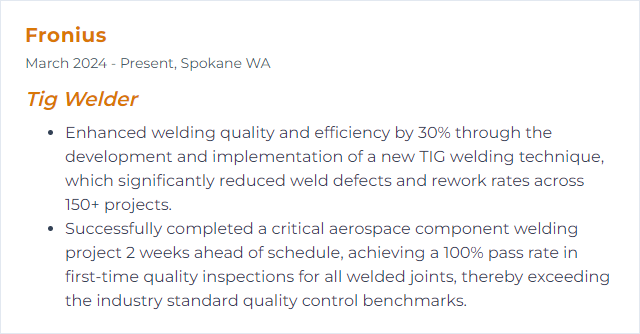
7. Pipe Welding
Pipe TIG demands control around the clock—literally. Root to cap, in position, with consistent penetration and a leak-tight finish.
Why It's Important
Pipelines carry everything from water to hydrogen. Integrity isn’t optional; it’s the whole point.
How to Improve Pipe Welding Skills
Prep and fit: Consistent land and gap. Feather tacks and ensure true alignment—no high-low.
Root pass discipline: Tight arc, deliberate keyhole, steady fill. Back-purge stainless and exotic alloys until the root is sugar-free.
Positions: Drill 1G through 6G. Walking the cup builds rhythm; freehand develops reach.
Heat and purge control: Monitor interpass temps and oxygen levels when purging to protect the root color.
Practice: Coupons, then real joints with varying schedules and diameters. Repetition across positions locks it in.
Safety: Confined spaces and elevated work increase risk—ventilate, tie off, communicate.
How to Display Pipe Welding Skills on Your Resume
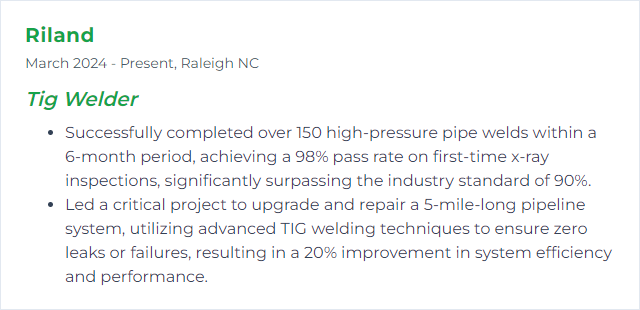
8. Stainless Steel
Stainless—chromium-rich and corrosion resistant—rewards clean technique and punishes contamination. TIG shows its best side.
Why It's Important
Food service, pharma, energy, aerospace—clean, strong welds that resist corrosion are the ticket in.
How to Improve Stainless Steel Skills
Keep it spotless: Dedicated brushes, wipes, and abrasives. No carbon steel tools near your stainless work.
Heat input: Lower is better. Tight arc, gas lens, correct cup, and brisk travel to reduce heat tint and sensitization.
Back purging: For tubing and sanitary work, hold oxygen low to keep the root silver, not sugared.
Filler choices: 308L, 309L, 316L based on base metal and service. Mind corrosion and temperature demands.
Post-weld care: Remove heat tint; consider pickling/passivation where specified to restore corrosion resistance.
How to Display Stainless Steel Skills on Your Resume
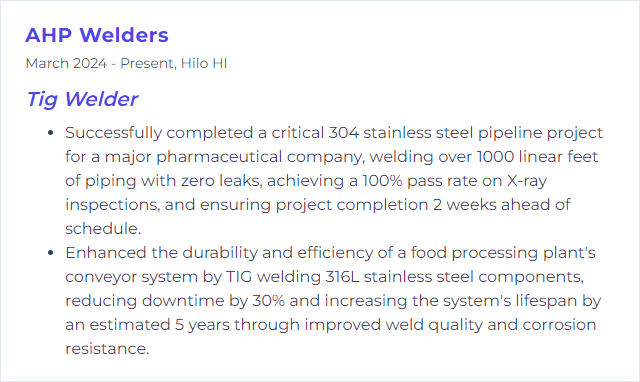
9. Aluminum Welding
Aluminum conducts heat fast and hides defects under an oxide skin. TIG on AC cuts through that layer and lays down clean fusion when tuned right.
Why It's Important
Lightweight structures in automotive, marine, and aerospace depend on sound aluminum welds that don’t crack or sag.
How to Improve Aluminum Welding Skills
Clean aggressively: Degrease, then stainless brush just before welding to break oxide. Keep everything dedicated to aluminum.
Set AC smartly: Balance and frequency tailored to joint needs—enough cleaning without carving your tungsten. High-frequency start keeps it smooth.
Tungsten selection: 2% lanthanated excels on inverters for AC; maintain a slightly rounded tip. Older machines may prefer zirconiated.
Filler and preheat: 4043 vs. 5356 based on strength and crack sensitivity. Preheat thick sections modestly to stabilize puddles.
Technique: Short arc, steady travel, and crater fill to avoid shrink cracks at the stop.
How to Display Aluminum Welding Skills on Your Resume
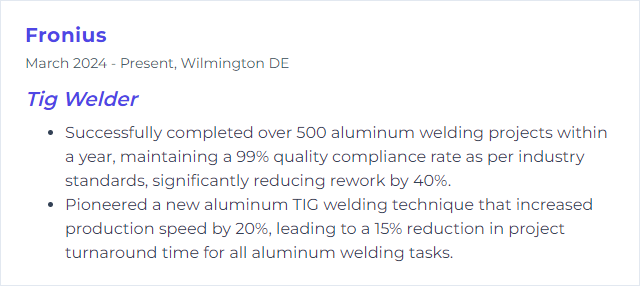
10. Aerospace Standards
Aerospace welding demands tight procedures, rigorous inspection, and airtight documentation. Every bead is traceable; every variable controlled.
Why It's Important
Parts go airborne. Reliability isn’t suggested—it’s required.
How to Improve Aerospace Standards Skills
Certify and qualify: Align to applicable aerospace welding codes and procedures. Maintain current welder performance qualifications.
Documentation: WPS/PQR, weld maps, traveler sign-offs, material certs, and heat lot traceability—complete and legible.
Process control: Calibrated machines, controlled consumables, tool control, and FOD prevention.
NDT coverage: Plan inspection per risk—VT/PT/UT/RT/PAUT where required, with acceptance criteria defined.
Change management: No parameter drift or substitutions without formal approval. Lock down variables.
How to Display Aerospace Standards Skills on Your Resume

11. Welding Equipment Maintenance
Healthy machines make healthy welds. TIG gear needs routine checks, cleaning, and timely part replacements.
Why It's Important
It prevents downtime, keeps arcs stable, and extends the life of torches, cables, and power sources.
How to Improve Welding Equipment Maintenance Skills
Daily checks: Leads, connectors, torch bodies, back caps, and O-rings. Leak-test gas lines; confirm cylinder pressures.
Clean consumables: Cups, gas lenses, collets, and collet bodies free of debris. Replace worn parts before they cause arc wander.
Cooling and airflow: Maintain coolant levels for water-cooled torches. Keep intakes clear of dust.
Electrical integrity: Tighten lugs, inspect plugs, and verify ground paths. Repair damaged insulation immediately.
Schedule service: Periodic internal inspection, calibration if required, and firmware or control checks on modern inverters.
Store right: Dry, covered machines; rod tubes sealed; tools organized to prevent damage.
How to Display Welding Equipment Maintenance Skills on Your Resume

12. Non-Destructive Testing
NDT checks welds without harming them. Surface cracks, subsurface flaws, porosity—found and quantified, not guessed at.
Why It's Important
Integrity is verified. Critical parts stay in service safely, and defects get fixed before failure.
How to Improve Non-Destructive Testing Skills
Training and qualification: Follow recognized NDT personnel standards. Technique matters as much as equipment.
Right method, right time: VT for every weld; PT for surface-breaking flaws; MT for ferromagnetic parts; UT/PAUT or RT for volumetric inspection.
Calibrate and reference: Use known standards and maintain calibration intervals for accuracy.
Surface prep: Cleanliness boosts detection sensitivity, especially for PT and VT.
Records and criteria: Document results against the specified acceptance criteria. Be precise with indications.
How to Display Non-Destructive Testing Skills on Your Resume
